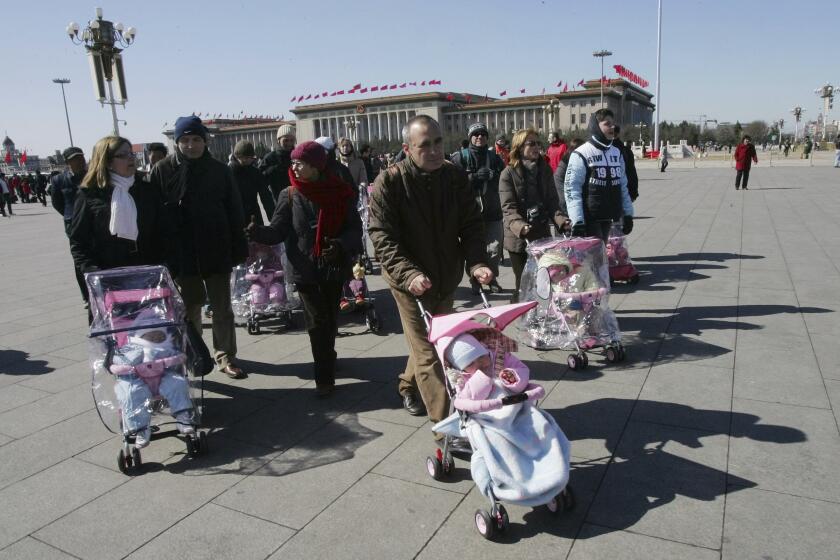Border Bill Takes a Detour
The Senate set the stage Thursday for a vote by week’s end on a bill to wall off 700 miles of the U.S. border from Mexico, but a lastminute push by senators concerned about the severe shortage of agricultural workers could derail the measure’s progress.
Senators agreed, by a vote of 71-28, to limit debate on the House-passed measure -- a tally that many see as an indicator of the outcome of a final vote, which could come as early as today.
But a surprise move by Sens. Dianne Feinstein (D-Calif.) and Larry E. Craig (R-Idaho) to add a guest worker program for agricultural workers has complicated matters.
The two senators planned to meet with Senate Majority Leader Bill Frist (R-Tenn.) this morning to press him yet again to consider adding their AgJobs proposal, intended to help farmers faced with rotting crops and thousands of dollars in lost revenue because they do not have enough workers to harvest their crops this year.
The senators’ move creates a dilemma for Frist, eager for victories to counter criticism of a GOP “do-nothing Congress.”
It also highlights the long-standing tension over immigration that is coming to a head in these waning days of the 109th Congress.
Republicans have built a broad-based election campaign based on security, saying their party can make America safer at the border and in the fight against terrorism. As part of this, House Republicans insist on an enforcement-only approach to immigration.
If Frist adds an agricultural guest worker program to the fence bill, the House is very unlikely to support it. If he refuses to add the agricultural program, as he has done for some time now, he will face strong opposition from Feinstein and Craig, who could rally other lawmakers against the measure. Craig said 80 lawmakers supported the AgJobs proposal.
On Thursday night, Craig said he believed there would be enough votes in the House to support the AgJobs proposal, but he acknowledged the tension surrounding immigration. “The House is in such a political panic about this issue,” he said.
In introducing the Secure Fence Act of 2006, Sen. Jeff Sessions (R-Ala.) described fences as “absolutely effective” at stopping illegal immigration and reducing crime.
Sen. Edward M. Kennedy (D-Mass.) blasted the measure. “They think this simple bumper sticker will work, but it won’t,” he said. “It’s a crass political effort by those more interested in saving their seats than securing the border.”
Approval of a fencing requirement could represent a victory for the House in its ongoing battle with the Senate over how immigration laws should be overhauled.
The chambers’ approaches differ: The Senate has supported a guest worker program and a path to citizenship for those now here illegally, along with stronger border security. The House has focused solely on enforcement. House leaders, who have refused to negotiate with the Senate, have pushed this week to get a series of enforcement-only measures through Congress.
But in a quiet power struggle that has unfolded behind closed doors this week, influential Republican senators have blocked House leaders from attaching the enforcement provisions to a series of spending bills.
The measures, which the House passed last week, include a provision that would make it easier to detain and deport suspected gang members.
The struggle over these provisions continues even as the legislative session enters its final days, and is holding up a defense policy bill.
Lacking legislative triumphs, Republicans in both chambers are representing the Homeland Security spending bill, with its funding for border security, as a victory.
The entire budget for border protection, immigration enforcement and related activity for fiscal 2007 is $21.3 billion, a 10% increase from last year.
“I think it’s very important for the American people to know that
When asked about stymied House attempts to attach additional enforcement measures to spending legislation, House Majority Leader John A. Boehner (R-Ohio) acknowledged: “There is clearly some concern about some of the border security issues that the House passed last week. We would have liked to have seen them in, but having said that
The Secure Fence Act would direct the Department of Homeland Security to study installing a state-of-the-art security system along the border with Canada, and would encourage the Customs and Border Protection agency to consider new ways of stopping smugglers -- options that Republican staffers say could include the use of rubber bullets.
The legislation recommends unmanned aerial vehicles, vehicle barriers and all-weather access roads, and specifically outlines requirements for at least two layers of reinforced fencing. Whereas the House bill dictates exactly where the fence should go in areas around Tecate and Calexico, Calif., and near border towns in New Mexico, Arizona and Texas, the Senate bill allows these communities to have more input on placement.
It also tones down House language giving Homeland Security 18 months to stop all illegal entries into the U.S.
Cost estimates for the 700-mile fence range from $2 billion to $9 billion.
The Senate approved its own 370-mile fence measure this year.
The fence requirement prompted fierce opposition from border communities, religious groups, advocates and lawmakers. The Tohono O’odham Nation of Arizona, whose land runs along 75 miles of the U.S.-Mexico border, has also expressed deep concern that the fence would threaten wildlife and the desert ecosystem.
Critics have also argued that it would make the border more violent; would force illegal immigrants to take more dangerous routes through the desert; would harm trade and relations with Mexico; and still wouldn’t solve the problem of illegal immigration.
Kennedy pointed out that at least 40% of illegal immigrants had entered the U.S. legally, through an airport, and simply overstayed their visas.
Supporters of such fences argue that they are an invaluable aid to border patrol agents and reduce the impact of illegal immigration on border communities. They often cite a 56% drop in crime in San Diego County since a fence was built in that area.
If the Secure Fence Act is not approved, the Homeland Security spending bill for fiscal 2007 will provide the department with $1.2 billion to continue adding physical reinforcements and barriers along the southern boundary with Mexico.
The department already erects fences, roads, vehicle barriers, lights and cameras along the border, complying with relevant laws and working with private and public land owners in doing so.
More to Read
Get the L.A. Times Politics newsletter
Deeply reported insights into legislation, politics and policy from Sacramento, Washington and beyond. In your inbox three times per week.
You may occasionally receive promotional content from the Los Angeles Times.






